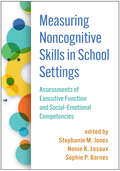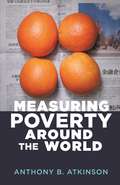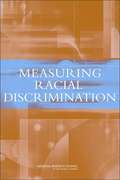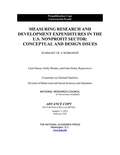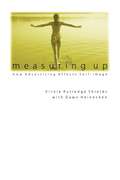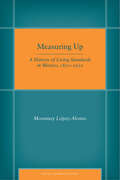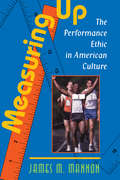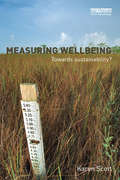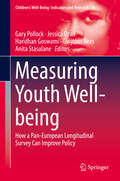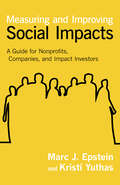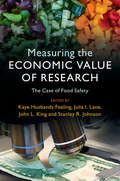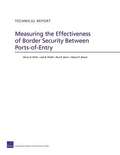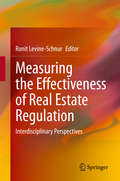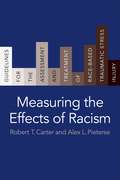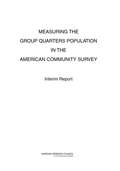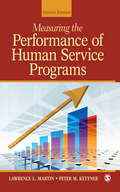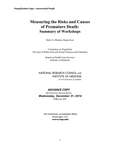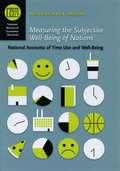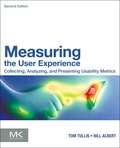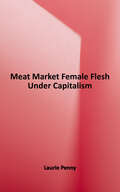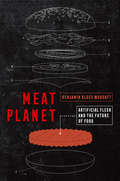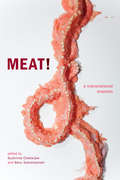- Table View
- List View
Measuring Noncognitive Skills in School Settings: Assessments of Executive Function and Social-Emotional Competencies
by Stephanie M. Jones, Nonie K. Lesaux and Sophie P. BarnesChildren's social–emotional and self-regulation skills are critical for success in school and, ultimately, in the workplace. How can educators determine the most effective approaches for measuring students' interpersonal competencies? And how can they use the data to improve their own practice? Relevant for school leaders, educators, researchers, and other stakeholders, this book brings together leading experts from multiple disciplines to discuss the current state of measurement and assessment of a broad range of noncognitive skills and present an array of innovative tools. Chapters describe measures targeting the individual student, classroom, whole school, and community; highlight implications for instructional decision making; examine key issues in methodology, practice, and policy; and share examples of systematic school- and districtwide implementation.
Measuring Poverty around the World
by Anthony B. AtkinsonThe final book from a towering pioneer in the study of poverty and inequality—a critically important examination of poverty around the worldIn this, his final book, economist Anthony Atkinson, one of the world’s great social scientists and a pioneer in the study of poverty and inequality, offers an inspiring analysis of a central question: What is poverty and how much of it is there around the globe? The persistence of poverty—in rich and poor countries alike—is one of the most serious problems facing humanity. Better measurement of poverty is essential for raising awareness, motivating action, designing good policy, gauging progress, and holding political leaders accountable for meeting targets. To help make this possible, Atkinson provides a critically important examination of how poverty is—and should be—measured.Bringing together evidence about the nature and extent of poverty across the world and including case studies of sixty countries, Atkinson addresses both financial poverty and other indicators of deprivation. He starts from first principles about the meaning of poverty, translates these into concrete measures, and analyzes the data to which the measures can be applied. Crucially, he integrates international organizations’ measurements of poverty with countries’ own national analyses.Atkinson died before he was able to complete the book, but at his request it was edited for publication by two of his colleagues, John Micklewright and Andrea Brandolini. In addition, François Bourguignon and Nicholas Stern provide afterwords that address key issues from the unfinished chapters: how poverty relates to growth, inequality, and climate change.The result is an essential contribution to efforts to alleviate poverty around the world.
Measuring Progress in Obesity Prevention
by Nutrition Board Committee on Accelerating Progress in Obesity Prevention FoodNearly 69 percent of U. S. adults and 32 percent of children are either overweight or obese, creating an annual medical cost burden that may reach $147 billion. Researchers and policy makers are eager to identify improved measures of environmental and policy factors that contribute to obesity prevention. The IOM formed the Committee on Accelerating Progress in Obesity Prevention to review the IOM's past obesity-related recommendations, identify a set of recommendations for future action, and recommend indicators of progress in implementing these actions. The committee held a workshop in March 2011 about how to improve measurement of progress in obesity prevention.
Measuring Racial Discrimination
by National Research Council of the National AcademiesMany racial and ethnic groups in the United States, including blacks, Hispanics, Asians, American Indians, and others, have historically faced severe discrimination—pervasive and open denial of civil, social, political, educational, and economic opportunities. Today, large differences among racial and ethnic groups continue to exist in employment, income and wealth, housing, education, criminal justice, health, and other areas. While many factors may contribute to such differences, their size and extent suggest that various forms of discriminatory treatment persist in U.S. society and serve to undercut the achievement of equal opportunity. Measuring Racial Discrimination considers the definition of race and racial discrimination, reviews the existing techniques used to measure racial discrimination, and identifies new tools and areas for future research. The book conducts a thorough evaluation of current methodologies for a wide range of circumstances in which racial discrimination may occur, and makes recommendations on how to better assess the presence and effects of discrimination.
Measuring Research and Development Expenditures in the U.S. Nonprofit Sector: Summary of a Workshop
by Carol HouseNational Center for Science and Engineering Statistics (NCSES) of the National Science Foundation is responsible for national reporting of the research and development (R&D) activities that occur in all sectors of the United States economy. For most sectors, including the business and higher education sectors, NCSES collects data on these activities on a regular basis. However, data on R&D within the nonprofit sector have not been collected in 18 years, a time period which has seen dynamic and rapid growth of the sector. NCSES decided to design and implement a new survey of nonprofits, and commissioned this workshop to provide a forum to discuss conceptual and design issues and methods. "Measuring Research and Development Expenditures in the U. S. Nonprofit Sector: Conceptual and Design Issues" summarizes the presentations and discussion of the workshop. This report identifies concepts and issues for the design of a survey of R&D expenditures made by nonprofit organizations, considering the goals, content, statistical methodology, data quality, and data products associated with this data collection. The report also considers the broader usefulness of the data for understanding the nature of the nonprofit sector and their R&D activities. "Measuring Research and Development Expenditures in the U. S. Nonprofit Sector" will help readers understand the role of nonprofit sector given its enormous size and scope as well as its contribution to identifying new forms of R&D beyond production processes and new technology.
Measuring Up
by Dawn Heinecken Vickie Rutledge ShieldsThe mute gestures of advertising images are frozen for posterity by photographers and illustrators, gestures that, for better or worse, perpetuate a certain aesthetic and eventually become emblematic of a period. The images of today display the values of a society that has more interest in the body than the mind. They are technoenhanced labyrinths of unattainable appearances that leave women and men feeling horrified, estranged, and restricted by unrealistic, silent mandates. Measuring Up looks at advertising as more than just a way to extract money from unsuspecting people but as a vehicle for conveying the larger views of a confining, body-obsessed culture. By weaving theoretical and textual insights from feminist and cultural studies with the voices of real women and men, Measuring Up offers a unique reception analysis of the effects of repetitious exposure to advertisements of perfect bodies in our everyday lives. Shields examines a particular, complex relationship between the idealized images of gender we see in advertising and our own thoughts, feelings, and behavior in relation to these images. The study is unique in presenting audience reception in terms of ethnographic data, not textual interpretations alone. Measuring Up engages with and informs current theoretical debates within these sometimes complementary and sometimes contradictory literatures: feminist media studies, feminist film theory, critical social theory, cultural studies, and critical ethnography. This is an important work that explores the forms and channels of power used in one of the most insidious and overt means of mass influence in popular culture.
Measuring Up: A History of Living Standards in Mexico, 1850-1950
by Moramay Lopez-AlonsoMeasuring Uptraces the high levels of poverty and inequality that Mexico faced in the mid-twentieth century. Using newly developed multidisciplinary techniques, the book provides a perspective on living standards in Mexico prior to the first measurement of income distribution in 1957. By offering an account of material living conditions and their repercussions on biological standards of living between 1850 and 1950, it sheds new light on the life of the marginalized during this period. Measuring Upshows that new methodologies allow us to examine the history of individuals who were not integrated into the formal economy. Using anthropometric history techniques, the book assesses how a large portion of the population was affected by piecemeal policies and flaws in the process of economic modernization and growth. It contributes to our understanding of the origins of poverty and inequality, and conveys a much-needed, long-term perspective on the living conditions of the Mexican working classes.
Measuring Up: The Performance Ethic In American Culture
by James MannonThis is an exploration of the problems caused by the relentless pressure many Americans feel to measure up successfully in respect of school grades, beauty, economic achievement, and various quantified aptitudes. The book focuses on various aspects, both major and minor, of social and cultural life, discussing topics such as culture, socialization, peer groups, reference groups, presentations of self, gender roles, class inequality, deindustrialization, corporate downsizing, status systems, and human agency. Having taken his critical look at modern cultural values that support the performance ethic, the author concludes with hope for a reorientation of values that could promote a more productive sense of identity in America.
Measuring Wellbeing: Towards Sustainability?
by Karen ScottImproving wellbeing and sustainability are central goals of government, but are they in conflict? This engaging new book reviews that question and its implications for public policy through a focus on indicators. It highlights tensions on the one hand between various constructs of wellbeing and sustainable development, and on the other between current individual and societal notions of wellbeing. It recommends a clearer conceptual framework for policy makers regarding different wellbeing constructs which would facilitate more transparent discussions. Arguing against a win-win scenario of wellbeing and sustainability, it advocates an approach based on recognising and valuing conflicting views where notions of participation and power are central to discussions. Measuring Wellbeing is divided into two parts. The first part provides a critical review of the field, drawing widely on international research but contextualised within recent UK wellbeing policy discourses. The second part embeds the theory in a case study based on the author’s own experience of trying to develop quality of life indicators within a local authority, against the backdrop of increasing national policy interest in measuring ‘happiness’. This accessible and informative book, covering uniquely both practice and theory, will be of great appeal to students, academics and policy makers interested in wellbeing, sustainable development, indicators, public policy, community participation, power and discourse.
Measuring Youth Well-being: How A Pan-european Longitudinal Survey Can Improve Policy (Children's Well-being: Indicators and Research Ser. #19)
by Gwyther Rees Gary Pollock Jessica Ozan Haridhan Goswami Anita StasulaneThis volume presents key findings from the EU funded Measuring Youth Well-being (MYWeB) project which assessed the feasibility of a European Longitudinal Study for Children and Young People (ELSCYP). It draws on the original empirical data from a panel of experts in the field of child well-being as well as field experiences from a number of European countries. MYWeB explored strategies and methodological challenges for involving children and young people in well-being research in order to fight poverty and social exclusion. It does so by evaluating different options to measure the well-being of children and young people across Europe using a child centric approach.Written by experts researching children and young people from a variety of disciplinary backgrounds in the areas of sociology, psychology, political science, education, philosophy, economics, social policy, and evaluation.
Measuring and Improving Social Impacts: A Guide for Nonprofits, Companies, and Impact Investors
by Marc J. Epstein Kristi YuthasPhilanthropic NGOs, foundations, and corporations face endlessly competing needs when deciding to invest or donate for maximum social impact. This book fills an enormous gap by providing a system to measure, operationalize, and improve any organization's impact investments.
Measuring the Economic Value of Research: The Case Of Food Safety
by Kaye Husbands Fealing Julia I. Lane John L. King Stanley R. JohnsonThe scientific advances that underpin economic growth and human health would not be possible without research investments. Yet demonstrating the impact of research programs is a challenge, especially in areas that span disciplines, industrial sectors, and encompass both public and private sector activity. All areas of research are under pressure to demonstrate benefits from federal funding of research. This exciting and innovative study demonstrates new methods and tools to trace the impact of federal research funding on the structure of research, and the subsequent economic activities of funded researchers. The case study is food safety research, which is critical to avoiding outbreaks of disease. The authors make use of an extraordinary new data infrastructure and apply new techniques in text analysis. Focusing on the impact of US federal food safety research, this book develops vital data-intensive methodologies that have a real world application to many other scientific fields.
Measuring the Effectiveness of Border Security Between Ports-of-Entry
by Henry H. Willis Paul K. Davis Wayne P. Brown Joel B. PreddThis report offers research and recommendations on ways to measure the overall efforts of the national border-security enterprise between ports of entry. Focusing on three missions--illegal drug control, counterterrorism, and illegal migration--this report recommends ways to measure performance of U.S. border-security efforts in terms of interdiction, deterrence, and exploiting networked intelligence.
Measuring the Effectiveness of Real Estate Regulation: Interdisciplinary Perspectives
by Ronit Levine-SchnurThis book discusses the fundamental issues regarding the effect of real estate regulation on housing, urban development, and considerations of justice and efficiency. Bringing together the contributions of prominent scholars representing diverse methodologies and academic disciplines, this book offers new perspectives on core topics such as the effectiveness of land use regulation in terms of housing availability, enhanced equality, and sustainable development; and different modes of regulation and their mutual influences. The book’s eleven chapters are divided into five parts which address different aspects of real estate regulation, combining theoretical analysis with a close observation of diverse case studies, from North America and Europe to China, the Middle East, and developing economies. Part I offers cutting-edge analysis on how to measure, model, and understand the impact of zoning and other modes of real estate regulation, from economic and normative theoretical viewpoints. Part II complements Part I by providing historical observations and empirical knowledge on the actual contribution of zoning and historical conservation regulation to cities’ shape. Part III considers the outcomes of business and industrial land development policies. Part IV studies urban land development regulation and allows to compare between two relevant case studies—one from Germany, and the other from Poland. Finally, Part V concerns standardization in the real estate market by analyzing the justification and outcomes of such attempts, particularly in the mortgages market. Providing an interface between theory and practice, the book will appeal to a broad audience, consisting of scholars, policy-makers, practitioners, and students, interested in an interdisciplinary overlook on real estate regulation.
Measuring the Effects of Racism: Guidelines for the Assessment and Treatment of Race-Based Traumatic Stress Injury
by Robert T. Carter Alex L. PieterseA large body of research has established a causal relationship between experiences of racial discrimination and adverse effects on mental and physical health. In Measuring the Effects of Racism, Robert T. Carter and Alex L. Pieterse offer a manual for mental health professionals on how to understand, assess, and treat the effects of racism as a psychological injury.Carter and Pieterse provide guidance on how to recognize the psychological effects of racism and racial discrimination. They propose an approach to understanding racism that connects particular experiences and incidents with a person’s individual psychological and emotional response. They detail how to evaluate the specific effects of race-based encounters that produce psychological distress and possibly impairment or trauma. Carter and Pieterse outline therapeutic interventions for use with individuals and groups who have experienced racial trauma, and they draw attention to the importance of racial awareness for practitioners. The book features a racial-trauma assessment toolkit, including a race-based traumatic-stress symptoms scale and interview schedule. Useful for both scholars and practitioners, including social workers, educators, and counselors, Measuring the Effects of Racism offers a new framework of race-based traumatic stress that helps legitimize psychological reactions to experiences of racism.
Measuring the Group Quarters Population in the American Community Survey: Interim Report
by National Research Council of the National AcademiesFollowing several years of testing and evaluation, the American Community Survey (ACS) was launched in 2005 as a replacement for the census "long form," used to collect detailed social, economic, and housing data from a sample of the U.S. population as part of the decennial census. During the first year of the ACS implementation, the Census Bureau collected data only from households. In 2006 a sample of group quarters (GQs) -- such as correctional facilities, nursing homes, and college dorms -- was added to more closely mirror the design of the census long-form sample. The design of the ACS relies on monthly samples that are cumulated to produce multiyear estimates based on 1, 3, and 5 years of data. The data published by the Census Bureau for a geographic area depend on the area's size. The multiyear averaging approach enables the Census Bureau to produce estimates that are intended to be robust enough to release for small areas, such as the smallest governmental units and census block groups. However, the sparseness of the GQ representation in the monthly samples affects the quality of the estimates in many small areas that have large GQ populations relative to the total population. The Census Bureau asked the National Research Council to review and evaluate the statistical methods used for measuring the GQ population. This book presents recommendations addressing improvements in the sample design, sample allocation, weighting, and estimation procedures to assist the Census Bureau's work in the very near term, while further research is conducted to address the underlying question of the relative importance and costs of the GQ data collection in the context of the overall ACS design.
Measuring the Performance of Human Service Programs
by Dr Peter M. Kettner Dr Lawrence L. MartinToday stakeholders demand accountability from government and nongovernmental human service organizations. Performance measurement has become the major method of performance accountability. So how can human service organizations develop and utilize program output, quality, and outcome performance measures to satisfy stakeholders? This Second Edition of Measuring the Performance of Human Service Programs explains in detail how to measure and assess program effectiveness. With special attention given to the four types of outcome performance measures—numeric counts, standardized measures, level of functioning (LOF) scales, and client satisfaction—this updated classic is the only resource focused exclusively on performance accountability and performance measurement in the human services. Features in This Edition Provides a fundamental understanding of performance accountability and performance measurement in human service programs with comprehensive and up-to-date materialUtilizes the systems model as a conceptual framework— a common conceptual framework in social work and the human services Explains the different types of output (efficiency) performance measures—time, episode, material Includes updated examples of efficiency, quality, and effectiveness performance measures in human service organizations An Instructor's Resource site (http://www.sagepub.com/martinmeas2einstr) offers PowerPoint slides for each chapter and suggested assignments to accompany each chapter.Intended Audience This book is designed for graduate courses on social work and human services and is also a invaluable resource for practitioners in human service organizations.
Measuring the Risks and Causes of Premature Death: Summary of Workshops
by Holly G. Rhodes"Measuring the Risks and Causes of Premature Death" is the summary of two workshops conducted by The Committee on Population of the National Research Council at the National Academies to address the data sources, science and future research needs to understand the causes of premature mortality in the United States. The workshops reviewed previous work in the field in light of new data generated as part of the work of the NRC Panel on Understanding Divergent Trends in Longevity in High-Income Countries (NRC, 2011) and the NRC/IOM Panel on Understanding Cross-National Differences Among High-Income Countries (NRC/IOM, 2013). The workshop presentations considered the state of the science of measuring the determinants of the causes of premature death, assessed the availability and quality of data sources, and charted future courses of action to improve the understanding of the causes of premature death. Presenters shared their approaches to and results of measuring premature mortality and specific risk factors, with a particular focus on those factors most amenable to improvement through public health policy. This report summarizes the presentations and discussion of both workshops.
Measuring the Subjective Well-being of Nations: National Accounts of Time Use and Well-being
by Alan B. KruegerSurely everyone wants to know the source of happiness, and indeed, economists and social scientists are increasingly interested in the study and effects of subjective well-being. Putting forward a rigorous method and new data for measuring, comparing, and analyzing the relationship between well-being and the way people spend their time-across countries, demographic groups, and history-this book will help set the agenda of research and policy for decades to come. It does so by introducing a system of National Time Accounting (NTA), which relies on individuals' own evaluations of their emotional experiences during various uses of time, a distinct departure from subjective measures such as life satisfaction and objective measures such as the Gross Domestic Product. A distinguished group of contributors here summarize the NTA method, provide illustrative findings about well-being based on NTA, and subject the approach to a rigorous conceptual and methodological critique that advances the field. As subjective well-being is topical in economics, psychology, and other social sciences, this book should have cross-disciplinary appeal.
Measuring the User Experience: Collecting, Analyzing, and Presenting Usability Metrics (Second Edition)
by William Albert Thomas TullisMeasuring the User Experience was the first book that focused on how to quantify the user experience. Now in the second edition, the authors include new material on how recent technologies have made it easier and more effective to collect a broader range of data about the user experience. As more UX and web professionals need to justify their design decisions with solid, reliable data, Measuring the User Experience provides the quantitative analysis training that these professionals need. The second edition presents new metrics such as emotional engagement, personas, keystroke analysis, and net promoter score. It also examines how new technologies coming from neuro-marketing and online market research can refine user experience measurement, helping usability and user experience practitioners make business cases to stakeholders. The book also contains new research and updated examples, including tips on writing online survey questions, six new case studies, and examples using the most recent version of Excel. Learn which metrics to select for every case, including behavioral, physiological, emotional, aesthetic, gestural, verbal, and physical, as well as more specialized metrics such as eye-tracking and clickstream data. Find a vendor-neutral examination of how to measure the user experience with web sites, digital products, and virtually any other type of product or system. Discover in-depth global case studies showing how organizations have successfully used metrics and the information they revealed. Companion site, www. measuringux. com, includes articles, tools, spreadsheets, presentations, and other resources to help you effectively measure the user experience
Meat
by Simon FairlieFairlie, editor of Land Magazine and former livestock manager of a community farm in the UK offers a collection of essays on the environmental ethics of eating meat. He considers whether raising animals for meat is sustainable and along the way debunks many of the environmental arguments and statistics used to promote veganism and vegetarianism. Essays are grouped into the categories of land requirements for livestock, food security, energy and carbon, and land use change, and while UK centric, will be of interest to anyone concerned with making sustainable food choices. Fairlie does not address the morality of eating meat, nor does he discuss nutrition, but nevertheless provides a compelling argument for small-scale livestock farming as an environmentally sound practice. Several of the essays were published previously in Land Magazine and have been revised for this collection. Annotation ©2011 Book News, Inc. , Portland, OR (booknews. com)
Meat Market: Female Flesh Under Capitalism
by Laurie PennyModern culture is obsessed with controlling women's bodies. Our societies are saturated with images of unreal, idealized female beauty whilst real female bodies and the women who inhabit them are alienated from their own personal and political potential. Under modern capitalism, women are both consumers and consumed: Meat Market offers strategies for resisting this gory cycle of consumption, exposing how the trade in female flesh extends into every part of women's political selfhood. Touching on sexuality, prostitution, hunger, consumption, eating disorders, housework, transsexualism, and the global trade in the signs and signifiers of femininity, Meat Market is a thin, bloody sliver of feminist dialectic, dissecting women's bodies as the fleshy fulcrum of capitalist cannibalism.
Meat Matters: Ethnographic Refractions of the Beta Israel (Sephardi and Mizrahi Studies)
by Hagar SalamonMeat Matters offers a portrait of the lives of Ethiopian Jews as it is reflected and refracted thought the symbolism of meat. Drawing upon thirty years of fieldwork, this beautifully written and innovatively constructed ethnography tells the story of the Beta Israel, who began immigrating from Ethiopia to Israel in the 1970s. Once in Israel, their world changed in formerly unimaginable ways, such as conversion under Rabbinic restrictions, moving into multistory buildings, different attitudes toward gender and reproduction, and perhaps above all, the newly acquired distinctiveness of the color of their bodies.In the face of such changes, the Beta Israel held on to a key idiom in their lives: meat. The community continues to be organized into kirchas, groups of friends and family who purchase and raise cows, then butcher and divide the animal's body into small and equal chunks, which are distributed among the kircha through a lottery ritual. Flowing back and forth between Ethiopia to Israel, Meat Matters follows the many strands of significance surrounding cows and meat, ultimately forming a vibrant web of meaning at the heart of the Beta Israel community today.
Meat Planet: Artificial Flesh and the Future of Food (California Studies in Food and Culture #69)
by Benjamin Aldes WurgaftIn 2013, a Dutch scientist unveiled the world’s first laboratory-created hamburger. Since then, the idea of producing meat, not from live animals but from carefully cultured tissues, has spread like wildfire through the media. Meanwhile, cultured meat researchers race against population growth and climate change in an effort to make sustainable protein. Meat Planet explores the quest to generate meat in the lab—a substance sometimes called “cultured meat”—and asks what it means to imagine that this is the future of food.Neither an advocate nor a critic of cultured meat, Benjamin Aldes Wurgaft spent five years researching the phenomenon. In Meat Planet, he reveals how debates about lab-grown meat reach beyond debates about food, examining the links between appetite, growth, and capitalism. Could satiating the growing appetite for meat actually lead to our undoing? Are we simply using one technology to undo the damage caused by another? Like all problems in our food system, the meat problem is not merely a problem of production. It is intrinsically social and political, and it demands that we examine questions of justice and desirable modes of living in a shared and finite world. Benjamin Wurgaft tells a story that could utterly transform the way we think of animals, the way we relate to farmland, the way we use water, and the way we think about population and our fragile ecosystem’s capacity to sustain life. He argues that even if cultured meat does not “succeed,” it functions—much like science fiction—as a crucial mirror that we can hold up to our contemporary fleshy dysfunctions.
Meat!: A Transnational Analysis (ANIMA: Critical Race Studies Otherwise)
by Sushmita Chatterjee and Banu SubramaniamWhat is meat? Is it simply food to consume, or a metaphor for our own bodies? Can “bloody” vegan burgers, petri dish beef, live animals, or human milk be categorized as meat? In pursuing these questions, the contributors to Meat! trace the shifting boundaries of the meanings of meat across time, geography, and cultures. In studies of chicken, fish, milk, barbecue, fake meat, animal sacrifice, cannibalism, exotic meat, frozen meat, and other manifestations of meat, they highlight meat's entanglements with race, gender, sexuality, and disability. From the imperial politics embedded in labeling canned white tuna as “the chicken of the sea” to the relationship between beef bans, yoga, and bodily purity in Hindu nationalist politics, the contributors demonstrate how meat is an ideal vantage point from which to better understand transnational circuits of power and ideology as well as the histories of colonialism, ableism, and sexism.Contributors Neel Ahuja, Irina Aristarkhova, Sushmita Chatterjee, Mel Y. Chen, Kim Q. Hall, Jennifer A. Hamilton, Anita Mannur, Elspeth Probyn, Parama Roy, Banu Subramaniam, Angela Willey, Psyche Williams-Forson
